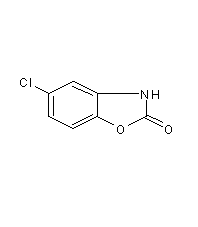Chlorzoxazone

Structural formula
| Physical competition number | 028V |
|---|---|
| Molecular formula | C7H4ClNO2 |
| Molecular weight | 169.57 |
| label |
5-Chloro-2-benzoxazolone, Chlorzoxazone, 5-Chloro-2-benzoxazolone, 5-Chloro-2-benzoxazolone, 5-Chloro-2-hydroxybenzoxazole |
Numbering system
CAS number:95-25-0
MDL number:MFCD00005717
EINECS number:202-403-9
RTECS number:DM5250000
BRN number:None
PubChem number:24277702
Physical property data
1. Properties: Crystal.
2. Density (g/mL, 20℃): Undetermined
3. Relative vapor density (g/mL, air=1): Undetermined
4. Melting point (ºC): 191~191.5
5. Boiling point (ºC, normal pressure): Undetermined
6. Boiling point (ºC, KPa): Undetermined
7. Refractive index: Undetermined
8. Flash point (ºC): Undetermined
9. Specific rotation (º): Undetermined
p>
10. Autoignition point or ignition temperature (ºC): Undetermined
11. Vapor pressure (mmHg, ºC): Undetermined
12. Saturated vapor pressure (kPa, ºC): Undetermined
13. Heat of combustion (KJ/mol): Undetermined
14. Critical temperature (ºC): Undetermined
15. Critical pressure (KPa): Undetermined
16. Log value of oil-water (octanol/water) distribution coefficient: Undetermined
17. Explosion upper limit (%, V /V): Undetermined
18. Lower explosion limit (%, V/V): Undetermined
19. Solubility: Easily soluble in ammonia, soluble in methanol, ethanol, Isopropyl alcohol, slightly soluble in water.
Toxicological data
1. Acute toxicity: rat oral LD50: 763mg/kg; rat intraperitoneal LD50: 150mg/kg; mouse oral LD50: 900mg/kg; mouse intraperitoneal LD50: 4400mg/kg; mouse Intraperitoneal LD50: 50mg/kg; Subcutaneous LD50 in mice: 170mg/kg; Oral LD50 in hamsters: 662mg/kg; Intraperitoneal LD50 in hamsters: 166mg/kg; Mammalian intraperitoneal LD50: 550mg/kg;
Ecological data
Slightly harmful to water.
Molecular structure data
1. Molar refractive index: 39.18
2. Molar volume (cm3/mol): 114.0
3. Isotonic specific volume (90.2K ): 303.2
4. Surface tension (dyne/cm): 50.0
5. Polarizability (10-24cm3): 15.53
Compute chemical data
1. Reference value for hydrophobic parameter calculation (XlogP): None
2. Number of hydrogen bond donors: 1
3. Number of hydrogen bond acceptors: 2
4. Number of rotatable chemical bonds: 0
5. Number of tautomers: 2
6. Topological molecule polar surface area 38.3
7 .Number of heavy atoms: 11
8. Surface charge: 0
9. Complexity: 185
10. Number of isotope atoms: 0
11. Determine the number of atomic stereocenters: 0
12. Uncertain number of atomic stereocenters: 0
13. Determine the number of chemical bond stereocenters: 0
14. Number of uncertain chemical bond stereocenters: 0
15. Number of covalent bond units: 1
Properties and stability
Avoid contact with oxides.
Storage method
Store sealed in a cool, dry place. Make sure the workspace has good ventilation. Keep sealed. Keep away from sources of fire and store away from oxidizing agents.
Synthesis method
It is prepared from 2-amino-5-chlorobenzoxazole.
Purpose
None
extended-reading:https://www.morpholine.org/teda-l33b-dabco-polycat-gel-catalyst/extended-reading:https://www.newtopchem.com/archives/44087extended-reading:https://www.cyclohexylamine.net/dabco-2039-catalyst-2039/extended-reading:https://www.bdmaee.net/niax-a-4e-tertiary-amine-catalyst-momentive/extended-reading:https://www.newtopchem.com/archives/38913extended-reading:https://www.newtopchem.com/archives/1120extended-reading:https://www.newtopchem.com/archives/category/products/page/132extended-reading:https://www.bdmaee.net/wp-content/uploads/2021/05/138-2.jpgextended-reading:https://www.bdmaee.net/dabco-nem-catalyst-cas100-74-3-evonik-germany/extended-reading:https://www.bdmaee.net/dioctyl-dimaleate-di-n-octyl-tin-cas33568-99-9-dioctyl-dimaleate-di-n-octyl-tin/


